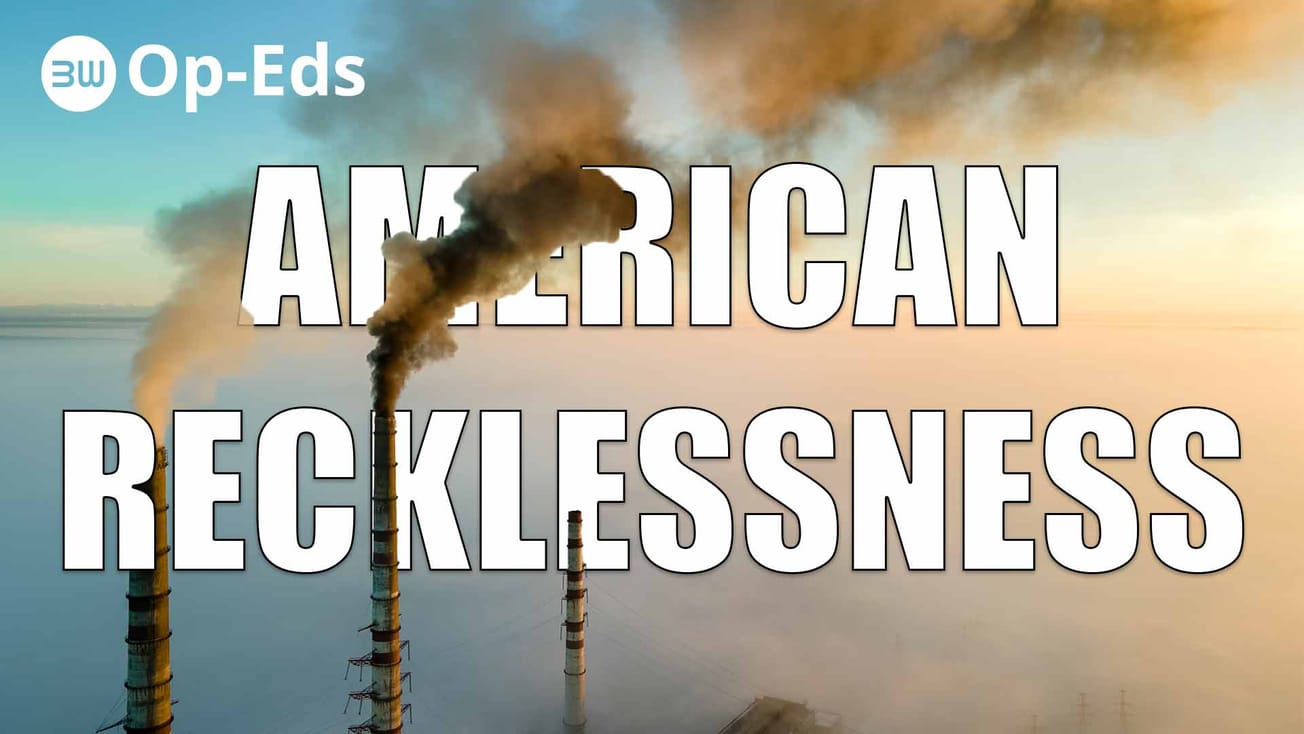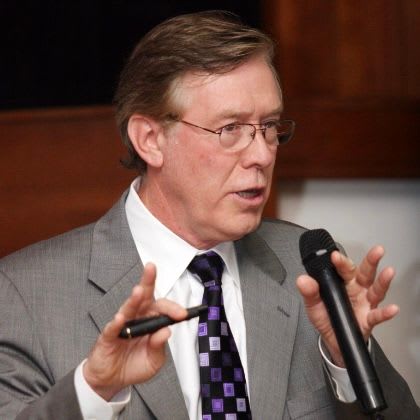The Trump administration's regulatory rollbacks and policy shifts reveal a deeply troubling outcome- the prioritization of America's industrial and economic power at the expense of personal health and a sustainable environment. This stance reflects a dangerous misalignment of values, sacrificing essential public protections in pursuit of short-term economic gains. The consequences of these decisions will reverberate far into the future, harming communities, ecosystems, and public trust.
Under the Trump Administration, the United States has dangerously departed from global norms, adopting environmental and public health policies that starkly contrast with the protective stances of the European Union (EU) and China. While the EU and China have actively strengthened regulations addressing climate change, toxic chemical management—including stringent bans on hazardous substances like PFAS and harmful pesticides—alongside robust standards for food and drug safety, the Trump Administration has instead pursued aggressive deregulation.
This prioritization of short-term industrial gain over long-term human and ecological wellbeing has exposed Americans to increased environmental health risks and compromised the nation's global leadership in sustainability. Europe's and China's proactive policies is fostering safer environments, cleaner food and water, and more secure medicines, while Trump's deregulatory agenda is leaving citizens vulnerable and ecosystems damaged.
The following provides a comprehensive comparison highlighting the stark differences between the Trump Administration's alarming approach to protecting public health and the environment, and the contrasting, more protective policies implemented by the European Union and China.
Climate Change Policy
United States
Despite being among the world's largest greenhouse gas emitters, the United States has taken a sharply divergent—and dangerously regressive—approach to climate policy under the Trump Administration. President Trump announced America's withdrawal from the Paris Agreement during his first term, signaling a stark retreat from global climate leadership. Since beginning his second term in January 2025, he has launched an aggressive campaign of deregulation explicitly benefiting the fossil fuel industry.
Central to these efforts is the declaration of a "National Energy Emergency," expediting oil and gas project approvals while suspending crucial environmental safeguards. EPA Administrator Lee Zeldin has announced sweeping rollbacks of environmental protections, including critical safeguards for wetlands and emissions limits from vehicles and industrial polluters. These actions are accompanied by dramatic cuts to the agency's budget and staffing—crippling its ability to enforce environmental laws effectively.
The nation's climate progress has stalled dramatically; the U.S. originally pledged a 26–28% emissions reduction by 2025 (compared to 2005 levels) under Paris commitments, yet Trump's policy reversals have set the country on course for only around a 17% reduction. By consistently dismissing climate science and enthusiastically promoting coal, oil, and gas, Trump's policies have firmly established the U.S. as a global "climate laggard," jeopardizing public health, the environment, and international credibility for short-term economic gains.
European Union
In contrast, the European Union has clearly established itself as a global leader in climate action through ambitious, proactive, and collaborative policies. Between 2020 and 2025, the EU not only upheld its Paris Agreement commitments but significantly raised its climate targets, committing to an impressive 55% reduction in greenhouse gas emissions by 2030 compared to 1990 levels—far surpassing its original 40% goal.
This increased ambition forms the core of the European Green Deal, reinforced by binding legislation that mandates achieving net-zero emissions by 2050. The EU has implemented rigorous, tangible measures, including strengthening the Emissions Trading System, imposing stricter carbon dioxide standards for vehicles, and introducing the comprehensive "Fit for 55" legislative package.
The impact of these robust policies is undeniable: by 2019, the EU's emissions were already 24% lower than in 1990, and by 2020 this reduction reached an estimated 31%. The EU's steadfast approach and measurable success illustrate a firm commitment to protecting global climate stability, demonstrating decisive leadership and international cooperation.
China
As a developing nation, China has embraced a dual strategy of economic growth alongside ambitious climate pledges. In September 2020, China committed to peak carbon dioxide emissions by 2030 and achieve full carbon neutrality by 2060—landmark goals that have significantly energized global climate diplomacy. A survey conducted in late 2024 indicated that 44% of climate experts believe China's CO₂ emissions have either already peaked or will do so in 2025.
Domestically, China has invested aggressively in renewable energy infrastructure, emerging as the global leader in solar and wind energy installations, and has pioneered a national carbon emissions trading scheme launched in 2021. Despite these commendable actions, China's continued reliance on coal-fired power plants means its total emissions surpassed 14 gigatons, representing approximately 27% of global emissions.
China's centralized governance structure has enabled swift policy implementation, evidenced by rapid adoption of renewable energy and the world's largest production of electric vehicles. China's ambitious climate commitments have injected critical momentum into global climate negotiations, while targeted policies have already delivered measurable improvements in urban air quality.
By 2030, the environmental legacy of the Trump Administration will be evident as its deregulatory policies significantly hinder America's progress in combating climate change. While the European Union decisively reduced its emissions and China moves forward with renewable energy projects, the missed opportunity for meaningful action under Trump will resonate for decades, leaving an enduring impact on both the global environment and public wellbeing.
Toxic Chemical Regulation
Regulatory approaches to toxic chemicals—particularly persistent "forever chemicals" such as PFAS and hazardous pesticides—differ significantly among major global powers, with the Trump Administration embracing deregulation while the EU and China implement increasingly protective measures.
United States
A glaring example of prioritizing economic growth over public health is the Trump administration's systematic dismantling of protections against toxic "forever chemicals" known as PFAS. These highly persistent substances are linked to cancer, hormonal disruption, liver disease, and reproductive harm. By withdrawing federal plans to establish stringent effluent discharge limits, the administration has effectively given a green light for continued industrial pollution, knowingly exposing communities to these harmful chemicals.
The Environmental Protection Agency (EPA) has launched a sweeping campaign of deregulation that undermines critical protections against hazardous chemicals and plastics. By actively dismantling state-level restrictions and redefining chemical risk evaluations, the Trump EPA is positioning itself to nullify essential safeguards, including California's stringent Proposition 65 and the federal asbestos ban.
Equally concerning was the EPA's decision to reverse a proposed ban on chlorpyrifos, a highly toxic pesticide with established links to developmental disabilities in children. This reversal disregarded unequivocal scientific evidence and authorized the continued widespread use of millions of pounds of chlorpyrifos annually across American agriculture, directly endangering the health of children and agricultural workers.
Further exacerbating this dangerous pattern, the Trump administration is actively facilitating regulatory exemptions for polluting industries. Industrial groups can now request sweeping two-year exemptions from vital EPA regulations on hazardous air pollutants, including mercury and benzene—both known carcinogens. This deregulation threatens air quality and significantly elevates public health risks, disproportionately affecting disadvantaged communities.
European Union
In contrast, the European Union has demonstrated consistent commitment to protecting public health through rigorous chemical regulations guided by the 'precautionary principle.' Between 2020 and 2025, the EU decisively intensified its commitment to eliminating hazardous substances by adopting the ambitious Chemicals Strategy for Sustainability, targeting notorious "forever chemicals" such as PFAS for comprehensive phase-out.
Building on existing bans, including the prohibition of PFOS and PFOA in 2020, the EU further cemented its global leadership by proposing in 2023 an unprecedented ban on all PFAS chemicals—allowing only strictly essential uses. If enacted by 2025–2026, this would represent the most robust regulation of PFAS globally, dramatically reducing exposure and associated health risks for millions.
The EU's proactive approach extends equally to pesticides. In January 2020, European regulators definitively banned chlorpyrifos following a thorough safety review that revealed no safe exposure levels. The EU also previously banned most outdoor uses of neonicotinoid insecticides in 2018—a group of pesticides that remain largely unrestricted in the U.S. A 2019 analysis revealed that the U.S. continued to approve 72 pesticides actively banned or phased out by the EU.
The measurable outcomes of these rigorous protections are significant: compared to the U.S., the European Union has reduced toxic residues in food, safer consumer goods, and improved public health outcomes. Europe's unwavering dedication to stringent regulation starkly contrasts with the dangerous deregulatory stance seen in the U.S.
China
Between 2020 and 2025, China demonstrated a clear commitment to strengthening its regulatory approach toward toxic chemicals, progressively aligning with international standards. As a signatory to the Stockholm Convention, China proactively banned the production of PFOS early on and began phasing out PFOA by 2020, further intensifying these efforts by updating its List of New Pollutants under Key Control in 2023.
China's progress is equally visible in its pesticide regulations. Over the past decade, it has banned or severely restricted highly hazardous pesticides like phorate, parathion, and paraquat. The nation's timely decision in 2016 to ban chlorpyrifos on vegetables, due to its acknowledged toxicity, illustrates an important step forward—though the pesticide remains partially in use, pending broader restrictions.
China's Ministry of Ecology and Environment's 2021 initiative to identify, screen, and manage "new pollutants," including various PFAS, marks an essential milestone in its ongoing effort to strengthen chemical regulation. Despite these commendable advancements, China's regulatory framework remains uneven, with enforcement inconsistencies and thousands of lesser-known toxic substances yet to be effectively controlled.
The Trump Administration's hazardously lenient approach to toxic chemical regulation has left American citizens alarmingly vulnerable to increased exposure to carcinogens and neurotoxins. This starkly contrasts with the European Union's proactive, stringent regulatory framework and China's steadily increasing efforts to regulate harmful chemicals. These distinct policy approaches profoundly impact environmental sustainability and public health, with Europe fostering healthier communities while U.S. communities continue to face the detrimental effects of contamination.
Food Safety Oversight
Food safety—ensuring that our meals remain uncontaminated from farm to fork—is a critical public health responsibility, yet recent policies have varied dramatically across major economies, with the Trump administration pursuing aggressive deregulation while the EU and China implement increasingly protective measures.
United States
The Trump administration's sweeping deregulation of food safety oversight poses significant risks to public health, dismantling critical protections designed to safeguard American consumers. One particularly troubling example is the administration's decision in March 2025 to dissolve two essential advisory committees—the National Advisory Committee on Microbiological Criteria for Foods (NACMCF) and the National Advisory Committee on Meat and Poultry Inspection (NACMPI). Their abrupt termination deprives policy-making processes of critical scientific input.
Further undermining public safety, significant workforce reductions within the Food and Drug Administration (FDA) have dramatically impacted the Unified Human Foods Program. The February 2025 resignation of Deputy Commissioner Jim Jones following these sweeping staff cuts underscores the severity of these reductions, compromising the FDA's ability to enforce food safety standards effectively.
Adding to these concerns, the administration has permanently increased production line speeds in poultry and pork processing plants. While industry lobbyists welcome these changes as a boost to productivity, faster line speeds directly threaten worker safety and compromise thorough food inspections, risking contaminated products reaching store shelves.
Under the Trump Administration, America's food safety policy increasingly relies on industry self-regulation. By cutting what was labeled as "red tape," the administration has permitted practices such as expanded use of chemical washes, reduced mandatory testing, and weakened critical safety standards. The impact is clear: the Centers for Disease Control and Prevention (CDC) reports approximately 48 million cases of foodborne illness annually, resulting in about 3,000 preventable deaths each year.
European Union
The European Union's approach to food safety exemplifies a model of rigorous, proactive, and science-driven regulation, consistently prioritizing public health above industrial convenience. Anchored in the General Food Law and enforced by the European Food Safety Authority (EFSA), the EU employs the precautionary principle—taking decisive action to ban or restrict substances and practices if they pose even a potential risk.
From 2020 to 2025, the EU intensified its already stringent standards through the ambitious Farm to Fork Strategy, a cornerstone of the broader Green Deal. Unlike the U.S., Europe outright prohibits controversial industry practices, including chlorine-washing of poultry, instead mandating stringent on-farm pathogen controls. Additionally, longstanding EU bans on growth-promoting antibiotics and hormone-treated livestock underscore Europe's commitment to safety and sustainability.
EU pesticide regulations also remain significantly stricter than in the U.S., exemplified by the 2020 ban on chlorpyrifos. After determining that no level of exposure was safe, the EU set default pesticide residue limits to the lowest possible detection threshold, effectively barring contaminated imports.
Europe's extensive use of traceability systems and robust networks, such as the Rapid Alert System for Food and Feed (RASFF), enables swift, coordinated responses across member states whenever contamination is detected. The effectiveness of this centralized system is clear in outcomes: Europe consistently experiences far fewer severe foodborne outbreaks relative to its population than the U.S.
China
Since the devastating 2008 melamine milk scandal severely undermined public trust, China has undertaken extensive reforms to transform its food safety system. Between 2020 and 2025, the country's commitment intensified, anchored by the comprehensive Food Safety Law and the creation of a powerful unified regulator, the State Administration for Market Regulation (SAMR).
In practice, these reforms led to dramatically increased inspections and enforcement actions, with tens of thousands of food enterprises scrutinized annually. The consequences for adulteration or sale of unsafe food have been severe, including heavy fines, imprisonment, lifetime industry bans, and even capital punishment in extreme cases. The government's seriousness is evident in substantial investment, with SAMR allocating approximately ¥18 billion (about $2.7 billion) specifically toward food safety oversight in 2021 alone.
High-profile enforcement campaigns vividly illustrate China's proactive stance, cracking down decisively on harmful practices such as unauthorized additives and unsafe infant formula. These intensive measures have shown measurable results: notorious adulterations like melamine contamination have virtually disappeared, and routine sample tests regularly surpass a 97% compliance rate.
Under the Trump administration, the United States is significantly relaxing food safety oversight, creating conditions ripe for increased contamination risks. In stark contrast, the European Union's rigorous food safety framework has resulted in substantially fewer outbreaks per capita, significantly boosting consumer trust. Meanwhile, China's recent sweeping reforms have yielded promising improvements, effectively reducing the most serious violations and steadily raising standards. The evidence is clear: strong, science-driven regulation—not deregulation—is essential for protecting public health.
Drug Safety Oversight
Oversight of pharmaceuticals and medical products is vital to safeguarding public health, yet approaches have diverged starkly following Trump's election, with the FDA pursuing an aggressive deregulation agenda while the EU and China maintain or strengthen protections.
United States
Under the controversial leadership of Health and Human Services Secretary Robert F. Kennedy Jr., the Trump administration has significantly weakened drug oversight, sparking deep concern among public health experts, pharmaceutical companies, and consumer advocates alike.
One of the most alarming aspects is the unprecedented reduction in critical staff. With the administration announcing plans to eliminate approximately 10,000 positions across the Department of Health and Human Services (HHS), including substantial layoffs within the Food and Drug Administration (FDA), the agency's capacity to effectively review and approve medications has been dramatically undermined.
One deeply troubling action has been Secretary Kennedy's elimination of public comment requirements. In February 2025, he rescinded the longstanding policy mandating public input prior to implementing NIH-related regulations. This unprecedented move significantly reduces transparency, allowing crucial policy changes to proceed unchecked and without adequate stakeholder involvement.
Furthermore, the abrupt termination of over 230 NIH grants specifically focused on HIV-related research—including an $18 million program aimed at preventing HIV transmission among adolescents and young adults—is profoundly misguided. This decision represents a devastating setback to ongoing efforts to combat HIV, jeopardizing years of progress and putting vulnerable populations at increased risk.
Perhaps most troubling are the administration's leadership appointments, characterized by individuals known for controversial positions on vaccines and alternative therapies. The selection of ideologically driven officials risks overshadowing objective scientific assessment in regulatory decisions, potentially eroding public trust in the integrity of health institutions.
European Union
The European Union sets a global benchmark in pharmaceutical safety through the rigorous oversight of its European Medicines Agency (EMA) and robust national regulators. The EU consistently prioritizes patient safety over rapid market access, often approving new medications slightly later than the U.S. FDA—but only after exhaustive scientific scrutiny.
This cautious approach was notably evident during the COVID-19 pandemic: while the FDA quickly granted emergency authorization to Pfizer/BioNTech's vaccine, the EMA took an additional 2–3 weeks to conduct an extensive formal review, ensuring comprehensive evaluation and bolstering public trust in vaccine safety.
The European regulatory framework, built around principles of transparency, precaution, and rigorous pharmacovigilance, consistently safeguards patients. The Pharmacovigilance Risk Assessment Committee (PRAC) continuously monitors adverse effects through the sophisticated EudraVigilance database, swiftly recommending necessary regulatory actions.
Europe's stringent regulatory measures translate into measurable benefits for citizens, who experience fewer unsafe medicines on their markets. Notably, drugs such as the diabetes medication rosiglitazone were promptly suspended by the EU in 2010 due to cardiovascular risks, whereas the U.S. merely restricted its use. Additionally, Europe's prohibition of direct-to-consumer pharmaceutical advertising helps ensure more responsible medication use.
China
Since 2020, China has embarked on an ambitious transformation of its pharmaceutical oversight, significantly strengthening drug safety and modernizing its regulatory practices. Prompted by past safety scandals and the urgent need to support medical innovation, China's National Medical Products Administration (NMPA) has undertaken sweeping reforms aimed at aligning with international best practices.
The introduction of China's nationwide Marketing Authorization Holder (MAH) system in December 2019 marked a profound shift in drug accountability. By allowing entities other than manufacturers to hold drug licenses and assume responsibility for safety, the MAH system incentivizes specialization, transparency, and stringent compliance.
The commitment to safety was unmistakably demonstrated in response to the 2018 vaccine scandal. The subsequent Vaccine Administration Law of 2019 established stricter oversight, harsher penalties, and rigorous inspections. The NMPA has proactively increased its scrutiny, boldly revoking manufacturing licenses of companies failing to meet quality standards.
China has substantially upgraded its post-market drug safety surveillance, enhancing its Adverse Drug Reaction (ADR) monitoring system and regularly publishing safety bulletins. This vigilance has led to meaningful regulatory actions, such as the 2020 restrictions on domperidone due to cardiac risks.
Under the Trump Administration, the FDA's globally respected reputation faces unprecedented challenges due to increased political interference. In contrast, Europe's EMA steadfastly adheres to its conservative, science-driven approach, choosing patient safety and thorough vetting over rapid market entry. China has shown remarkable progress, significantly elevating its pharmaceutical oversight to international standards. The stark differences in public health outcomes underscore the critical role of regulatory approaches in protecting patient safety.
Conclusion
From climate change to chemical safety, food regulation, and drug oversight, the Trump Administration's policies prioritize deregulation, short-term economic gains, and minimal government intervention—at the expense of public health and environmental sustainability. In stark contrast, the European Union embraces a precautionary, sustainable approach, emphasizing robust regulations designed explicitly to protect the health of citizens and environmental sustainability. Meanwhile, China rapidly advanced its regulatory framework, aligning more closely with Europe's model in response to international obligations and internal demands for improved health and ecological outcomes.
The regulatory divergence between these global powers is striking. Under Trump, the United States retreated from its leadership role on climate issues, rolled back crucial environmental safeguards, and left dangerous chemicals largely unchecked. Conversely, the EU intensified its commitment to aggressive emissions reductions and banned numerous toxic substances outright, thus safeguarding both its environment and citizens. China, recognizing the urgent need for reform, progressively enacted stricter standards, announcing ambitious long-term climate goals and gradually banning hazardous chemicals.
These policy differences have real, measurable impacts. By 2025, the EU's rigorous regulatory environment has resulted in lower greenhouse gas emissions, reduced chemical contamination, fewer foodborne illnesses, and increased public confidence in medicines. Conversely, the U.S.'s relaxed oversight under Trump will contribute to setbacks in public health and environmental outcomes, including higher chemical exposures and persistent use of banned pesticides. Meanwhile, China's evolving approach shows tangible benefits for its massive population through improved safety standards and proactive reforms—though ongoing enforcement challenges remain.
A particularly stark illustration is the opioid crisis. In the U.S., permissive pharmaceutical marketing and loose prescribing regulations led directly to tens of thousands of annual overdose deaths. Conversely, tighter European and Chinese controls effectively limited opioid misuse, demonstrating how rigorous regulatory oversight directly translates into lives saved.
Ultimately, the comparative outcomes across these regions underscore an essential truth: robust, science-based regulation profoundly benefits public health, environmental quality, and societal well-being. Short-term economic gains from deregulation can rapidly evaporate, leaving communities burdened by long-term health and environmental costs. The EU continues to push forward ambitiously toward climate neutrality and zero-pollution goals, setting an example of sustainability and responsibility. China's path remains pivotal, with its ongoing reforms holding profound implications for global environmental health.













